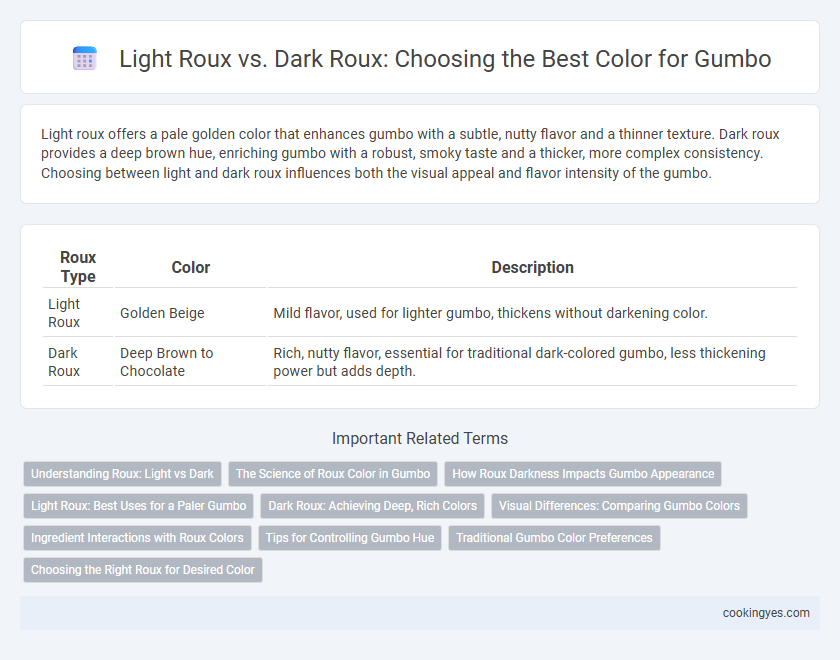Light roux offers a pale golden color that enhances gumbo with a subtle, nutty flavor and a thinner texture. Dark roux provides a deep brown hue, enriching gumbo with a robust, smoky taste and a thicker, more complex consistency. Choosing between light and dark roux influences both the visual appeal and flavor intensity of the gumbo.
Table of Comparison
| Roux Type | Color | Description |
|---|---|---|
| Light Roux | Golden Beige | Mild flavor, used for lighter gumbo, thickens without darkening color. |
| Dark Roux | Deep Brown to Chocolate | Rich, nutty flavor, essential for traditional dark-colored gumbo, less thickening power but adds depth. |
Understanding Roux: Light vs Dark
Light roux offers a pale, golden color and a mild, nutty flavor ideal for delicate gumbo varieties, while dark roux delivers a rich, deep brown color and robust, smoky taste that intensifies hearty dishes. The cooking time for light roux typically ranges from 5 to 10 minutes, achieving a softer flavor profile, whereas dark roux requires 20 to 30 minutes of careful stirring to avoid burning and develop complexity. Selecting the roux color directly influences gumbo's appearance and flavor depth, making understanding these variations crucial for authentic Creole and Cajun cuisine.
The Science of Roux Color in Gumbo
The science of roux color in gumbo hinges on the Maillard reaction and caramelization processes, where light roux offers a nutty flavor and pale golden hue due to shorter cooking times, while dark roux develops a deeper, richer brown color and complex taste from prolonged cooking. Light roux enhances gumbo's thickness without overpowering spices, preserving vibrant vegetable colors and a more delicate flavor profile. Dark roux, prized in Cajun tradition, imparts robust smoky notes and a darker color that transforms the soup's character, with some taste compounds diminishing as the roux darkens but flavor intensity increasing.
How Roux Darkness Impacts Gumbo Appearance
The darkness of the roux in gumbo directly influences its color, with light roux producing a golden or tan base that results in a lighter, more translucent broth, while dark roux yields a rich, deep brown hue that creates a visually robust and opaque texture. Light roux enhances the gumbo's appearance by emphasizing vibrant ingredients, whereas dark roux offers a caramelized, almost smoky gloss that signals intense flavor and depth. Color variations caused by roux darkness also affect the perceived richness and heartiness, crucial for authentic Southern-style gumbo presentation.
Light Roux: Best Uses for a Paler Gumbo
Light roux, made by cooking flour and oil just until they turn a pale beige, provides a subtle thickening agent and delicate flavor ideal for paler gumbos like chicken and sausage gumbo or seafood gumbo. Its mild color preserves the natural hues of ingredients while contributing a smooth, slightly nutty base without overwhelming the dish. Light roux is best suited for recipes where clarity and lighter visual presentation are desired, enhancing taste without darkening the gumbo's appearance.
Dark Roux: Achieving Deep, Rich Colors
Dark roux is essential for achieving a deep, rich color in gumbo, typically cooked until it reaches a dark chocolate brown hue, which enhances both flavor and appearance. The prolonged cooking process caramelizes the flour and fat, developing complex, nutty aromas and intensifying the gumbo's savory profile. While light roux adds subtle color and a mild taste, dark roux provides the signature rich depth that defines traditional Creole and Cajun gumbo.
Visual Differences: Comparing Gumbo Colors
Light roux in gumbo creates a golden-brown color, contributing a milder flavor and a thinner consistency, while dark roux produces a deep mahogany hue with a robust, nutty taste and thicker texture. The visual difference significantly impacts the gumbo's appeal, with light roux gumbo appearing brighter and more translucent, whereas dark roux gumbo showcases a rich, opaque finish. Chefs choose roux color based on desired flavor intensity and presentation, affecting the overall sensory experience.
Ingredient Interactions with Roux Colors
Light roux, cooked briefly to a pale blonde, preserves more starch content from flour, producing a smoother base that thickens gumbo without overpowering other flavors. Dark roux, with its deep brown color resulting from longer cooking, offers intense nutty and roasted notes due to Maillard reactions, but its thickening power diminishes as starches break down. The choice between light and dark roux affects ingredient interactions, as lighter roux enhances bold vegetable flavors like peppers and onions, while dark roux complements richer proteins such as sausage or seafood by balancing taste complexity.
Tips for Controlling Gumbo Hue
Light roux imparts a golden to tan color to gumbo, preserving the dish's bright, earthy tones, while dark roux provides a deep brown hue, enhancing richness and complexity. To control gumbo hue, monitor cooking time closely to prevent overheating, stir continuously to avoid burning, and adjust the roux's darkness depending on your desired flavor profile. Using a heavy-bottomed pan helps maintain even heat distribution, ensuring a consistent roux color that directly influences the gumbo's final appearance and taste.
Traditional Gumbo Color Preferences
Traditional gumbo recipes emphasize light roux for its golden-brown hue, providing a subtle, nutty flavor that complements the dish without overpowering it. Dark roux, with its deep brown to nearly black color, offers a richer, more robust taste and is preferred in Cajun-style gumbo for a pronounced smoky depth. Regional preferences dictate the choice, where Creole gumbo often favors lighter roux to maintain a balance of flavor and color, while Cajun gumbo leans towards dark roux for authenticity and intensity.
Choosing the Right Roux for Desired Color
Light roux offers a golden to tan color that brightens gumbo while providing a subtle, nutty flavor, making it ideal for lighter, more delicate dishes. Dark roux delivers a deep brown to chocolate hue with a robust, smoky taste that enhances the richness and complexity of traditional Cajun gumbo. Selecting the right roux depends on the desired color and flavor intensity, with light roux emphasizing brightness and dark roux emphasizing depth.
Light roux vs Dark roux for color Infographic

 cookingyes.com
cookingyes.com